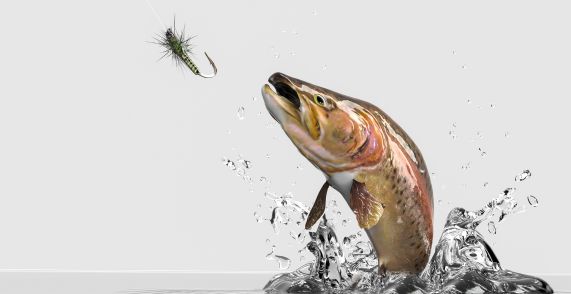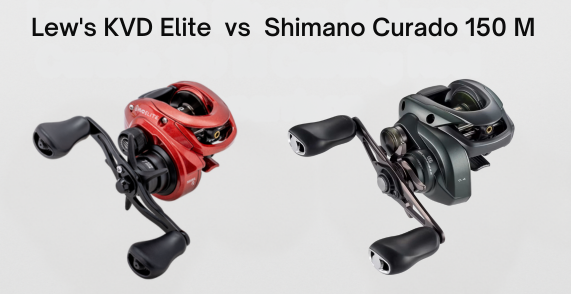Trout leaping out of water – a spectacle that nature lovers relish amidst the serene wild. But is it merely an act of joy, an aquatic version of celebration, as many anglers believe?
This seemingly playful transcendence from water to air by rainbow trout is indeed a breathtaking sight, but the reasons behind this action remain shrouded in mystery.
The short answer is this..
Rainbow trout will jump out of the water for several reasons, including to stabilize their swim bladder, to catch insects, and to evade predators. Jumping can also help dislodge debris from their gills and can be an indicator that they are active and ready to bite when fishing.
.Let’s take a closer look at each of these reasons
In This Post
Why Rainbow Trout Leap From the Water
1. Biological Cleaning Mechanisms
The act of jumping allows rainbow trout to dislodge harmful substances that can accumulate on their bodies or become lodged in their gills while feeding at the bottom of water bodies.
Imagine if you were cooking and accidentally spilled some seasoning on your hands. You would likely wash your hands under running water to remove the debris.
Rainbow trout utilize the forceful jump from the water to “cleanse” themselves of any unwanted particles they encounter during their foraging activities.
By vigorously shaking their bodies mid-air during a jump, rainbow trout rely on the inertia created by their movements to loosen any detritus clinging to their scales or trapped in their gill filaments.
As they re-enter the water, these dislodged particles are carried away by the current, leaving them refreshed and free from potentially harmful substances.
This biological cleaning mechanism also helps remove external parasites that may have attached themselves to the trout’s skin or scales.
These parasites can pose significant threats to the fish’s health by causing irritation, compromising natural bodily functions, or even transmitting diseases. Jumping out of the water disrupts and dislodges these unwanted hitchhikers, providing relief for the rainbow trout.
The combination of leaping from the water as a cleansing mechanism and stabilizing their swim bladders showcases how rainbow trout adapt to survive and thrive in their underwater habitats.
2. Swim Bladder Stabilization
Have you ever wondered why rainbow trout seemingly defy gravity and leap out of the water? One of the key reasons behind this behavior is to stabilize their swim bladder.
The swim bladder, an air-filled organ located in the fish’s abdomen, plays a crucial role in controlling buoyancy and helping them navigate through different depths of water.
When a rainbow trout rapidly changes depths in pursuit of prey or to evade predators, it can cause the air in their swim bladder to expand or compress, creating discomfort.
By propelling themselves out of the water, these agile fish can adjust the pressure inside their swim bladder, effectively equalizing it with the surrounding environment. This allows them to stabilize their buoyancy and maintain control as they move through varying water depths.
Swim bladder stabilization is especially important for rainbow trout as they inhabit diverse aquatic environments like rivers, streams, and lakes.
By having this skill, they can adapt to changing water conditions and maximize their chances of survival. It’s fascinating how nature has equipped these fish with adaptations that enable them to thrive in their dynamic underwater habitats.
To put this into perspective, imagine yourself on a roller coaster ride going up and down at high speeds. You might feel your ears pop due to changes in altitude. Similarly, rainbow trout experience discomfort due to rapid shifts in water depth.
Just like yawning or swallowing helps equalize the pressure in our ears during such moments, jumping allows rainbow trout to regulate pressure changes within their swim bladder..
3. Avoiding Predators and Obstacles
Rainbow trout are not only skilled jumpers but also nimble escape artists.
They are agile and adept swimmers, and they have developed jumping behaviors as a survival strategy. When faced with predators like large pike or other predatory fish, rainbow trout will often launch themselves out of the water to evade capture.
These acrobatic jumps can help them escape the jaws of their pursuers by creating distance between themselves and their predators. It’s a remarkable sight to witness a trout soaring through the air in a desperate bid for freedom.

But evading predators isn’t the only reason why rainbow trout jump. Another fascinating aspect of their jumping behavior is related to overcoming obstacles like waterfalls.
During their upstream spawning journeys, rainbow trout encounter small waterfalls and cascades that would impede their progress if they were unable to surmount them.
By propelling themselves out of the water, they are able to leap over these barriers and continue on their arduous journey to spawn in their preferred shallow gravel areas. It’s truly awe-inspiring how these fish use their natural athleticism to conquer obstacles in their environment.
Imagine standing by a rushing river as you observe a group of rainbow trout swimming against the current. Suddenly, one individual approaches a small waterfall blocking its way.
With a swift flick of its tail, it launches itself into the air, glistening drops flying in all directions, defying gravity for a brief moment before gracefully landing on the other side of the waterfall. This impressive display showcases nature’s ingenuity at its finest.
Now let’s dive deeper into another intriguing aspect of rainbow trout jumping: Feeding strategies.

Feeding Strategies and Jumping
While rainbow trout predominantly feed underwater by capturing prey such as aquatic insects, smaller fish, or even crustaceans, there are instances when they employ an efficient feeding tactic that involves jumping out of the water.
They typically have a diverse diet that includes insects like mayflies, caddisflies, midges, and even terrestrial insects that fall onto the water’s surface.
When these insects are present in abundance, particularly during hatches or when they’re active and buzzing near the water, rainbow trout seize the opportunity for a tasty meal.
These jumps are often observed when trout spot insects hovering on or near the water’s surface. In a swift, calculated movement, they launch themselves upward to snatch their prey before it escapes their reach.
This behavior isn’t just limited to adult trout; young trout are often more eager to feed on insects near or on the surface. As they grow larger, their feeding habits may shift towards deeper areas where they can find a more substantial meal.
Nonetheless, catching surface or near-surface insects remains an instinctual and efficient way for rainbow trout to satisfy their hunger.
They have learned to associate the presence of insects on the water with an opportunity for a quick and easy meal, prompting them to take advantage of these moments by employing their remarkable jumping abilities.
It’s a testament to the adaptability and resourcefulness of these magnificent creatures.
Picture yourself standing by a serene lake surrounded by lush greenery. The glassy surface ripples as trout begin to rise sporadically, creating small concentric circles that expand outward. Upon closer observation, you notice dragonflies darting above the water with reckless abandon.
Then, suddenly, a trout springs out of the depths, arching gracefully toward the sky as its jaws clamp around an unsuspecting dragonfly. Just like that, it disappears back into the depths, leaving you in awe of this delicate ballet between predator and prey.
- A study by the Fisheries and Oceans Canada estimates that about 50% of rainbow trout jumps are associated with feeding, specifically through capturing airborne or surface-level insects.
- Another research shows that up to 30% of their jumping actions are for evading predators, as well as clearing obstacles during spawning journeys.
- It is scientifically demonstrated that a rainbow trout can reach heights of up to 4.7 times their body length when jumping, most often seen during their aquatic acrobatics when hooked by anglers
The Impact of Hooking and Fighting
When anglers cast their lines and bait into the water in pursuit of these remarkable fish, they trigger an instinctive response that brings the trout bursting out from beneath the surface.
When a trout takes the bait and gets hooked, it instinctively goes into defense mode, exerting its strength to free itself from capture. This often involves vigorous leaps out of the water, accompanied by frenzied twisting and turning in an attempt to shake off the hook.

Picture yourself as the angler, feeling a tug on the line as you’re reeling in your catch. Suddenly, the tranquil river erupts as a magnificent rainbow trout propels itself into the air, putting on an awe-inspiring show of agility and power.
It’s a thrilling moment that signifies you’ve successfully hooked one of nature’s acrobats.
Rainbow trout are known for their incredible fighting ability, and their aerial displays during this struggle are not only impressive but also serve a purpose.
By leaping out of the water and thrashing about vigorously, they create additional tension on the line and increase their chances of escaping. In some cases, they might even succeed in dislodging the hook from their mouths with these acrobatics.
Beyond attempting to free themselves from captivity, jumping and fighting can also be a strategy to intimidate or confuse predators. By leaping out of harm’s way or creating sudden movements, they aim to startle would-be attackers or make themselves less vulnerable targets.

Recognizing Different Types of Rises
When it comes to trout fishing, recognizing the different types of rises can significantly increase your chances of success.
Each rise has its own distinct characteristics and indicates specific feeding behavior from the trout. By understanding these rises, you can tailor your fishing approaches to mimic the food sources and improve your chances of catching trout.
One common type of rise is known as the sipping rise. This is when a trout delicately sucks insects off the water surface without causing much disturbance.
It is often observed in calm waters and can be quite challenging to detect. To effectively target trout exhibiting this rise, opt for small and delicate dry flies that imitate tiny insects like midges or mayflies.
Another type of rise is the head poking rise. As the name suggests, during this rise, trout poke their heads out of the water to feed on insects they see floating on the surface.
This rise creates more visible disturbances on the water’s surface compared to sipping rises. When targeting trout displaying this behavior, consider using larger dry flies such as size 12-16 mayfly patterns.
In contrast to the subtle sipping and head poking rises, gulp rises are more explosive and noticeable. Trout exhibiting gulp rises aggressively ambush insects from below while breaking through the water’s surface with force.
These rises create a splash or wave-like disturbance which makes them easier to spot. When fishing for trout displaying gulp rises, consider using large attractor dry flies or streamer patterns that mimic an injured baitfish.
Trout may also exhibit sideways or backwards movements during their rising activity. These rises occur when trout are feeding along weed beds, edges of currents, or near structure where they have limited space for movement.
Watching for these unique rises can help you target areas with potential trout activity.
Understanding and recognizing these different types of rises requires observation skills and experience on the water.
While it may take time to develop this expertise, dedicating yourself to observing trout behavior and studying their feeding patterns will pay dividends in your fishing success.







